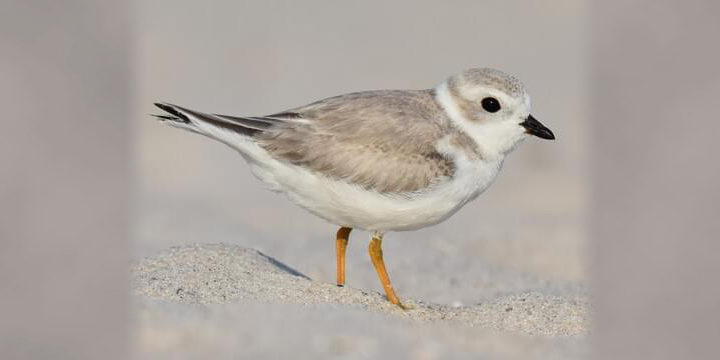Bird of The Week: Piping Plover
SCIENTIFIC NAME: Charadrius melodus
POPULATION: 8,000 individuals
TREND: Increasing
HABITAT: Nests on open sandy or gravel beaches and alkali flats; winters on beaches and mudflats
The small, sand-colored Piping Plover, named for its melodic, plaintive whistle, is a bird of beaches and barrier islands, sharing this habitat with Least Terns, Black Skimmers, and Wilson’s Plovers.
Beaches are also popular with people, and their impacts have caused serious declines in Piping Plover populations. Shoreline development and stabilization projects, free-roaming cats and other predators, poorly sited wind turbines, gas/oil industry operations, and global warming are some of the biggest threats to this species.
Beach Sprites
Piping Plovers resemble wind-up toys as they dart along the beach in search of food, taking a wide variety of insects, marine worms, and crustaceans. They nest in small depressions in the sand called scrapes and often nest in the same area with Least Terns.
Like many other plover species, adult Piping Plovers employ a “broken wing display” when threatened to draw attention to themselves and away from their chicks and nest.
Saving the Piping Plover
The Piping Plover is federally listed as Endangered in the Great Lakes region and Threatened in the remainder of its U.S. breeding range; it’s also listed as Endangered in Canada. The Great Lakes population is on the 2014 State of the Birds Watch List.
Critical Piping Plover nesting habitats are now protected to help the species during its breeding season. Populations have seen significant increases since the protection programs began, but the species remains in danger. For example, at popular Jones Beach near New York City, nesting Piping Plovers are threatened by a colony of feral cats. ABC is urging authorities to remove the cats for the safety of this federally protected species.
ABC is also leading a Gulf Coast conservation effort that is working to identify and implement protective measures for vulnerable beach-nesting birds and other birds, such as the Piping Plover, that winter there. Strategies include preservation of plover habitats; public education; limiting off-road vehicle (ORV) traffic; and limiting predation of free-roaming cats and dogs.
Source: American Bird Conservancy (abcbirds.org)


